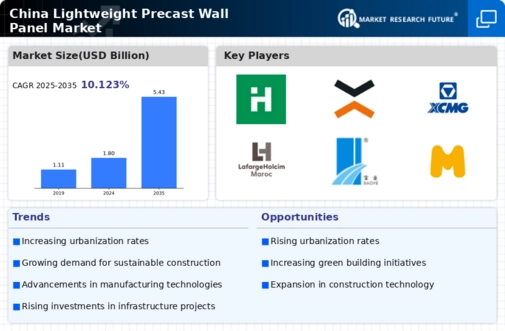Cost-Effectiveness of Construction
The lightweight precast-wall-panel market benefits from the growing recognition of cost-effectiveness in construction. Builders in China are increasingly aware that using lightweight precast wall panels can significantly reduce labor and material costs. The prefabrication process allows for quicker assembly on-site, which minimizes labor expenses and project timelines. Reports indicate that projects utilizing precast technology can save up to 20% in overall construction costs. This financial advantage is particularly appealing in a competitive market, where cost overruns can jeopardize project viability. Consequently, the lightweight precast-wall-panel market is likely to see sustained growth as more developers opt for these economically advantageous solutions.
Rising Demand for Energy Efficiency
The lightweight precast-wall-panel market in China is experiencing a notable surge in demand. This is driven by the increasing emphasis on energy efficiency in construction. As energy costs continue to rise, builders and developers are seeking materials that enhance thermal insulation and reduce energy consumption. Lightweight precast wall panels, known for their superior insulation properties, are becoming a preferred choice. According to recent data, energy-efficient buildings can reduce energy consumption by up to 30%, making them attractive to both consumers and investors. This trend aligns with China's broader goals of reducing carbon emissions and promoting sustainable building practices, thereby propelling the lightweight precast-wall-panel market forward.
Government Initiatives and Regulations
Government policies in China are playing a pivotal role in shaping the lightweight precast-wall-panel market. The Chinese government has implemented various initiatives aimed at promoting sustainable construction practices, including the use of precast materials. Regulations that mandate energy-efficient building standards are encouraging developers to adopt lightweight precast wall panels. For instance, the introduction of stricter building codes has led to a projected increase in the market size by approximately 15% over the next five years. These regulations not only support environmental goals but also stimulate economic growth within the construction sector, thereby enhancing the lightweight precast-wall-panel market.
Increased Urbanization and Housing Demand
The rapid urbanization in China is significantly impacting the lightweight precast-wall-panel market. With millions migrating to urban areas, there is an escalating demand for affordable housing solutions. Lightweight precast wall panels offer a viable option for quick and efficient construction of residential buildings. The ability to erect structures rapidly without compromising quality is appealing to developers facing tight deadlines. Current estimates suggest that urban housing demand could increase by 30% in the next decade, further driving the need for innovative construction materials. This trend positions the lightweight precast-wall-panel market as a key player in addressing the housing challenges posed by urbanization.
Technological Innovations in Manufacturing
Technological advancements in manufacturing processes are transforming the lightweight precast-wall-panel market in China. Innovations such as automated production lines and advanced materials are enhancing the quality and efficiency of precast wall panels. These technologies not only improve the structural integrity of the panels but also reduce waste during production. As a result, manufacturers can offer more competitive pricing while maintaining high standards. The integration of smart technologies in the production process is expected to increase market efficiency by approximately 25% over the next few years. This trend indicates a promising future for the lightweight precast-wall-panel market as it adapts to modern manufacturing demands.


















Leave a Comment